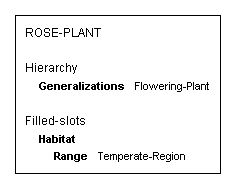KnEd is the software tool used by knowledge engineers to visually display and edit knowledge bases. It was created to help the users manage the complexity of the KM language. Not only do the users have to cope with KM's annotations, but they must also contend with other KM features, such as inverses and inheritance. In managing this complexity, KnEd provides an environment that is conducive to the development of knowledge bases.
KnEd provides two kinds of basic displays for viewing the knowledge base: text panes and tree panes. It also supports tools for editing the knowledge base.
Text panes display all the information in a frame, including simple assertions and annotations (see Section 1.3.4). They can also be used to edit the frame's contents. The text pane is the primary display used by the knowledge engineer.

Figure 11: The text pane for the Rose-Plant frame described in Figure 1
The basic text pane has the name of the frame in the upper left corner. The slots attached to the frame appear below the frame name and are indented two spaces to the right. The values of the slots appear to the right of the slots. Figure 11 is an example of a basic text pane for the Rose-Plant frame. It displays the values of the generalizations, parts, pollinated-by, stages, and symmetry slots of the Rose-Plant frame.
Annotations appear below the slot of the assertion that's being annotated and are indented two spaces to the right.

Figure 12: The text pane for the value annotation in Figure 3
Value annotations appear below and two spaces to the right of the value that's being annotated. The value that is being annotated appears first in capital letters. Below this and two spaces to the right, the slot part of the annotation appears, followed by its values. Figure 12 is KnEd's representation of the value annotation in Figure 3.

Figure 13: The text pane for the semantic annotation in Figure 4
Semantic annotations appear below and two spaces to the right of the assertion that's being annotated. The end value of the assertion that's being annotated appears first in capital letters. Below this and two spaces to the right, the slot part of the annotation appears, followed by its values. Figure 13 is KnEd's representation of the semantic annotation in Figure 4.

Figure 14: The text pane for the slot annotation in Figure 5
Slot annotations appear below and two spaces to the right of the slot that's being annotated. The slot part of the annotation appears first and is followed by the value of the slot. Figure 14 is KnEd's representation of the slot annotation in Figure 5.

Figure 15: The text pane for the nested annotation in Figure 6
Annotations can also be recursively nested. KnEd handles this by recursively applying the indentation strategy of the annotations until the nesting level of the assertion is reached. Figure 15 is KnEd's representation of the nested annotation in Figure 6.